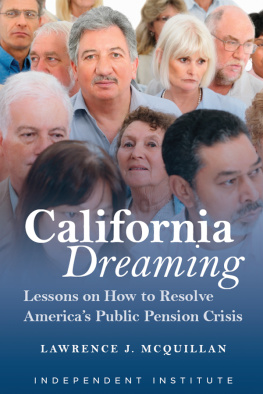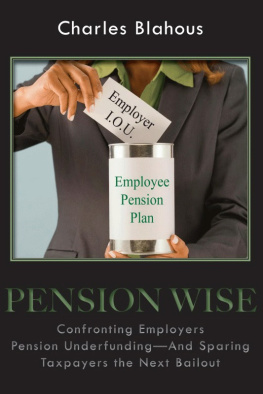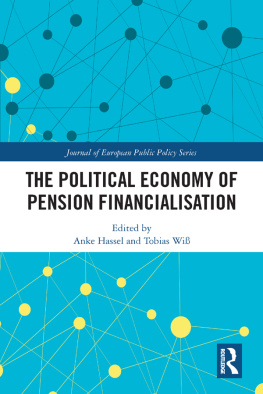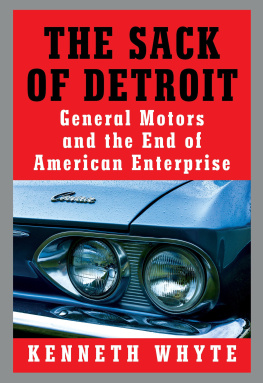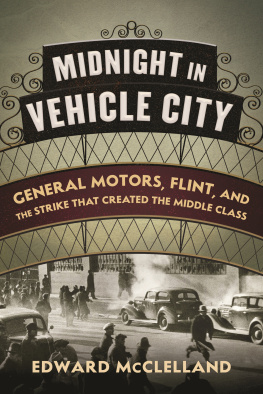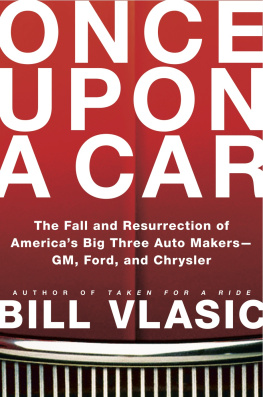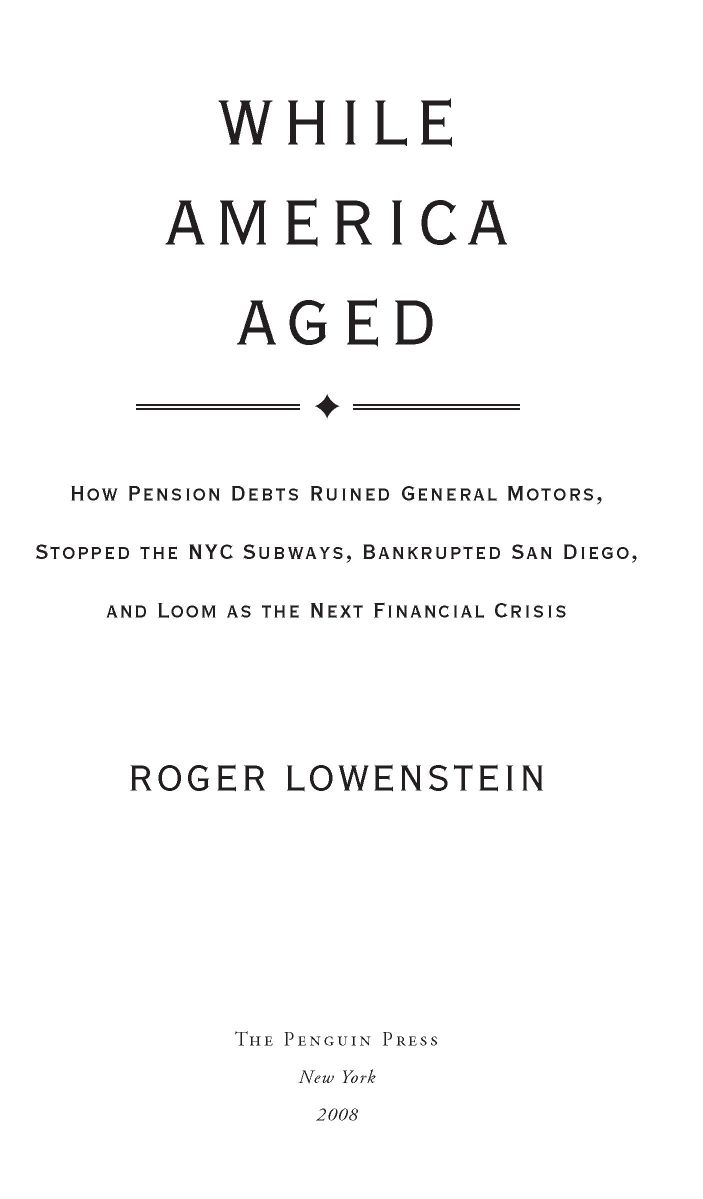Table of Contents
ALSO BY ROGER LOWENSTEIN
Origins of the Crash: The Great Bubble and Its Undoing
When Genius Failed: The Rise and Fall of Long-Term Capital Management
Buffett: The Making of an American Capitalist
To my father
INTRODUCTION
In the late 1960s, six of every ten Americans were covered by a pension plan, and it was possible to envision that soon the entire workforce would have its retirement security guaranteed. That dream has gone terribly sour. Pension sponsors from airlines to textile manufacturers to steel mills have gone belly up, and hundreds of others are now deeply in the red. More alarmingly, government employers such as cities and states have fallen behindfar behindon funding the promises they made to their retired workers.
America now faces a crisis of epidemic proportions. The fabric of the nations pension system is collapsingat the very moment when the population is rapidly aging. Today, America has approximately 38 million senior citizens; in a generation, the number will virtually double, to 72 million. Indeed, by 2030 one in five Americans will be over sixty-five.
Who will be there to provide for them? More than 60 million Americans either are receiving or have been promised pensions; however, their numbers are shrinking rapidly. In the private sector, the proportion of jobs with pensions has plummeted to just under 20 percent.
For workers still with pensions, plan assets are grossly inadequate. In the private sector, employers pension funds are, cumulatively, an astounding $350 billion in deficit.
Even worse, the states and localities, which have promised pensions to millions of present and future retired policemen, teachers, clerical workers and others, are hundreds of billions of dollars behind on their payments to state pension funds. This is money owed by the taxpayersand under the state constitutions, the debts must be paid; pensions can never be defaulted upon. Thus, the deficits will require a combination of layoffs, service cuts, and higher taxes in a majority of the states for decades to come. In the case of some of the worst offenders, such as New Jersey, West Virginia, and Illinois, the cuts will likely be draconian. Thanks to their grossly underfunded pensions, these states are essentially insolvent.
THIS BOOK examines how the pension system went so badly off course. All financial debacles have a human elementgreed or self-delusion or perhaps sheer dishonesty. In this one, retirement systems fell prey to a basic part of our naturethe urge to delay that which we find unpleasant now. Such behavior comes naturally to any child with a homework assignment (after dinner... when the game is over), and so it did to pension sponsors who deferred the required contributions.
Pensions are a perfect vehicle for procrastination; in the financial world, they are the most long-enduring promises that exist. The only rival is the federal Social Security systembut there, surprisingly, the commitment is not so airtight. Congress, if it chose, could reduce or cancel Social Security benefits tomorrow. Pensions are forever.
The young men who went to work for General Motors after World War II, when GM ruled the roost of American business, were promised pension and health care benefits that remained in force for half a century. One GM retiree, who died at 111 in 2006, had been collecting pension and retiree health benefits for forty-eight years. When he first went to work, in 1926, GMs managers could not have had the faintest conception of what the company could or would be paying in benefits eighty years later.
The very remoteness of the pension guarantee seduced many employers into overpromising (after all, when the benefits came due, they would be somebody elses problem). This tendency to overpromise was especially acute in the public sector, where employee unions had the power to vote politicians who werent sufficiently generous out of a job.
The story of pensions is, in fact, largely the story of the slow accretion of power by the labor unions. The first third of this book concerns the United Automobile Workers, who in a decade went from a ragtag bunch whose members were being beaten by paid union-busters to a formidable trade union that wrested pension and health care benefits from Detroit. (Retiree health care entails the same sort of long-term commitments, the same crushing obligations, and may be thought of as a companion to the pension problem.) Ultimately, the UAW drained out the value from once colossal companies, General Motors in particular. For impoverished GM shareholders, the sad irony is that Walter Reuther, the UAWs inspirational early leader, pointed the way toward a solution in the very beginningand GMs encrusted management did not want to hear it. In 2007, with the UAW and GM fighting a pitched battle over benefits, the union struck and shut the company down. Reuthers vision, which was carried to a dubious extreme, fueled the present crisis, but it also pointed to a way out.
The second part shifts the scene to the remarkable story of the then communist-run Transport Workers Unionwhich in the midst of the Great Depression organized the New York City subways. The TWU and its fiery leader, Mike Quill, played much the same role in the public sector as Reuther and the UAW did in private. Previous to the TWU, subway employees had to work until age seventy to qualify for a pension (and a meager one at that). Through a combination of strikes, threats, and not-so-subtle politicking, unions such as the TWU became a power in the legislature. Thanks to their efforts, New Yorks public servants now stand a fair chance of collecting a pension for longer than they worked, and in many cases they earn more in retirement (including Social Security) than they did on the job. Thus retirement has expanded from a modest sinecure at the sunset of life to a long and lucrative second career.
This is a topsy-turvy state of affairs, contrary to economic logic as well as common sense. Subway riders are paying higher fares so that the systems middle-class employees can retire at fifty-five and spend, like as not, three decades in a comfortable retirement. The Metropolitan Transportation Authority finally demanded reforms, and over Christmas 2005 New Yorkers got a frightening glimpse of the futurewhen a pension strike shut down their fabled transit system.
The drama in the subways pitted the people who operated the trains against the people who rode them: the public servants against the public. This is suggestive of the crisis in public pensions everywhere. In New York, at least, the battle was waged openly and on the issues. But many other pension sponsors have not been so forthright. For institutions under stress, pensions have been a tool for escaping the tough decisions. A sort of devils bargain is struck, whereby the unions (which know that pensions are constitutionally guaranteed) push for benefits that are beyond the ability of governments to properly fund. The unions get their promises; the politicians get to satisfy a powerful constituency. And by shortchanging their pension funds, they can run their budgets on borrowed time and put off the necessity to tax until a later generation.
The final section of this book concerns the City of San Diego, where just such a devils pact led to a sensational scandal that toppled the mayor, cost the local government its credit rating, and brought the city to the edge of bankruptcy. The scandal had its origins in the fertile soil of San Diegos laissez-faire political culture. The pressure on politicians to keep taxes low was unrelenting, and public servants brazenly conspired with union officials to raise benefits in the future in return for permission to underfund the pension now. This relaxed the immediate pressure on the budget, though it weakened the citys future finances for years and possibly decades. Many officials behaved less like councilmen and pension trustees than like the artful dodgers at Enron. But the essential abuseappealing to the electorate by shifting liabilities into the futureis altogether common. And the investigations and indictments that have riddled this still beleaguered city could happen anywhere. San Diego is a wake-up call to every community.




